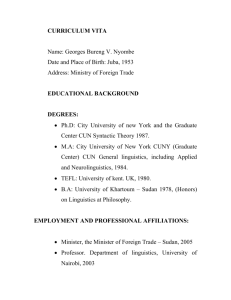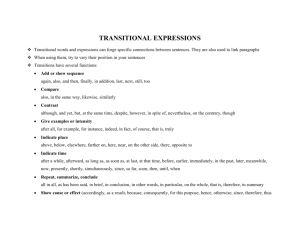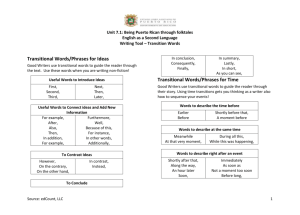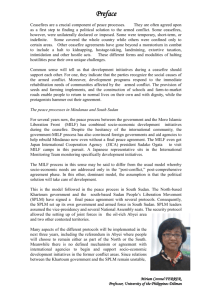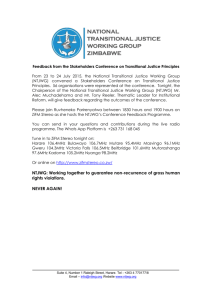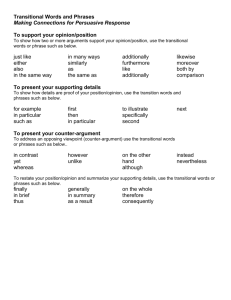Joint Monitoring and Evaluation Commission
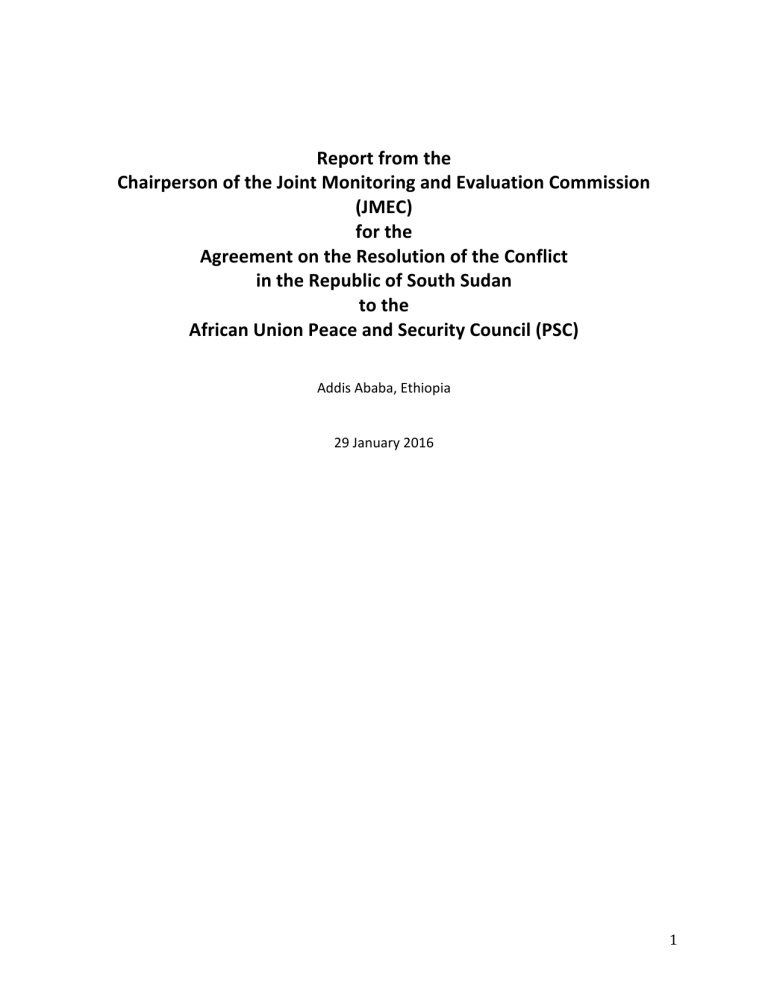
Report from the
Chairperson of the Joint Monitoring and Evaluation Commission
(JMEC) for the
Agreement on the Resolution of the Conflict in the Republic of South Sudan to the
African Union Peace and Security Council (PSC)
Addis Ababa, Ethiopia
29 January 2016
1
Executive Report
Implementation of the Agreement on the Resolution of the Conflict in the Republic of South
Sudan (the Agreement) is lagging far behind schedule. The Agreement risks becoming ineffectual in restoring long-term peace and stability to South Sudan without concerted efforts by the Parties and the international community to urgently address the situation. In the months immediately following the Agreement’s signature in August 2015, little implementation activity occurred, and the momentum generated by the signature of the Agreement has largely dissipated. Following my appointment as Chairperson of the Joint Monitoring and Evaluation
Commission (JMEC) in late October 2015, and the formation of the JMEC Secretariat in
November 2015, action has been taken to address deficiencies in implementation, and reinvigorate the process.
The pre-transitional period of 90 days provided for in the Agreement ended in late November without the formation of the Transitional Government of National Unity (TGoNU). At a meeting in Addis Ababa on 3 November 2015, the Chief Negotiators of the Parties, noting that little had been achieved, suggested a ‘reset’ of the implementation calendar in order to establish the
TGoNU between 15 December 2015 and 15 January 2016; however, scant progress was made towards this revised date, given the absence of the SPLM/A (In Opposition) from Juba, and the consequent inability of implementation institutions to begin their work. The absence of the
SPLM/A (In Opposition) from the first meeting of JMEC on 27 November 2015, who at that time had not returned to Juba for several reasons, including a dispute between the Parties over the size of the advance team delegation, contributed to the Commission’s inability to meet quorum. Unfortunately, disputes over the representation of other political parties continue to limit the inclusiveness of representation in the process envisaged by the Agreement. Other political parties remain unrepresented at JMEC, as well as in other key institutions where their participation was foreseen.
On 15 December 2015, to address the reality that the Agreement’s initial timetable for action had elapsed, and in order to overcome the impasse in the arrangements for the return of the
SPLM/A (In Opposition) to South Sudan, I issued an implementation calendar, with three objectives: first, to establish a practical and realistic timetable for the convening of key institutions and processes provided for in the Agreement; second, to set the conditions for the return of the SPLM/A (In Opposition) to Juba; and third, to provide a new date for the formation of the TGoNU, cognizant that the preliminary work that had yet to be completed prior to the establishment of a new government could still be achieved in the time available.
Implementation of the Agreement’s provisions accelerated in the latter half of December, and some of the key institutions provided for by the agreement were convened for the first time.
JMEC successfully met, with quorum, on 22 December 2015 following the arrival in Juba of the first group of the SPLM/A (In Opposition) advance party on 21 December 2015. A second meeting of JMEC was held on 12 January 2016.
2
Following the arrival of the SPLM/A (In Opposition) in Juba, the Joint Military Ceasefire
Commission (JMCC), the Ceasefire and Transitional Security Arrangements Monitoring
Mechanism (CTSAMM), and the National Constitutional Amendment Committee (NCAC) all began to meet and made some, albeit limited, progress in implementing their mandates as provided for in the Agreement, and what progress has been made must be seen in the context of the failure to form a TGoNU. The Parties have yet to complete crucial tasks such as the introduction of agreed transitional security arrangements for Juba, essential for the establishment of the TGoNU and in enabling the return to Juba of Dr. Riek Machar, incoming
First Vice President of the TGoNU.
On 7 January 2016, I facilitated the consensus selection of ministerial and deputy ministerial portfolios for the TGoNU. While the process did not strictly comply with the mechanism provided for in the Agreement, this variance from the terms of the Agreement was accepted as it had the support of all of the signatory parties to the Agreement, included the other political parties that had so far been absent from the process, and maintained the overall principle of inclusivity in the spirit of the Agreement. I also expected that consensus on the issue of ministerial selection would lead to the timely formation of the TGoNU, and the real work of the transition – restoring peace and stability and beginning the vital processes of reform and accountability required by the Agreement.
Initial steps towards the expansion of the existing National Legislative Assembly to the
Transitional National Legislative Assembly (TNLA) have been taken, with the nomination of the fifty supplementary members to be appointed by the SPLM/A (IO), and a decree by the
President of the Republic to formally appoint them. However, without the appointment of the remaining eighteen members (one for the SPLM (Former Detainees and seventeen for the other political parties), the TNLA will not be fully constituted.
Despite the progress made in December 2015 and January 2016, the TGoNU was not established by the revised date of 22 January 2016. A number of other important institutions and mechanisms, such as the Joint Operations Centre (JOC) and the Strategic Defence and
Security Review (SDSR) have yet to begin their work, and again, there is a limit to what can be achieved by any institutions in the absence of a fully participatory TGoNU.
The TGoNU has not been formed, in part, because of other departures from the framework of the Agreement. Chief amongst these was the unexpected decision by the Government to form
28 states, replacing the 10 states that comprised South Sudan at independence in 2011 and which existed at the time of signature of the Agreement. The President of South Sudan issued decrees on 24 December 2015, in which he formally dissolved the 10 states and created 28 new states. A number of provisions of the Agreement are predicated on the continuation of 10 states, with the expectation that states – both in terms of numbers and boundaries – could be re-examined in the course of developing a permanent constitution, the process for which is provided for in the transitional period of the Agreement. Therefore, the President’s actions contradict the terms of the Agreement. Both the SPLM/A (IO) and the SPLM (Former Detainees)
3
have made clear their opposition to the formation of 28 states, describing the existing government’s decision as unilateral, and a violation of the Agreement.
The Government, for its part, cites the popularity of creating new states as justification, and dismisses the complaints of the other parties. It further states that the power sharing formula can be applied as equally to 28 states as to 10, and that this should not present an obstacle to the Agreement. It is apparent to me that while in some areas of the country there is support for the creation of new states, this is far from a universally shared sentiment, particularly in the conflict-affected states of Jonglei, Unity and Upper Nile, which I witnessed first hand during visits to Bor, Malakal and Bentiu in December 2015 and January 2016. Irrespective of its popularity, absent an agreement between the signatory Parties to increase the number of states, the terms of the Agreement ought to prevail.
The Government’s action has created an impasse and challenges the spirit, as well as the sequence, of the implementation of the Agreement. The terms of the Agreement are supposed to be incorporated into the transitional constitution, but the Government refuses to agree to a new text for the transitional constitution that does not provide for 28 states; for its part, the
SPLM/A (IO) refuses to agree to a text that states anything other than 10 states. Almost all other work in the redrafting of the transitional constitution is complete. Although the TGoNU could be formed on the sole basis of the Agreement, which also provides that in the event a provision of the constitution conflicts with the Agreement, the latter prevails, the leader of the
SPLM/A (IO) has stated that he will not return to Juba to form the TGoNU without passage of an amended transitional constitution. This invariably requires resolution on the number of states, which the Government continues to insist is irrevocable. At the 12 January 2016 meeting of
JMEC, the Parties agreed to discuss, outside of the framework of Agreement and JMEC, the question of states, but such discussions have yet to produce agreement; subsequent to the 12
January meeting, the leadership of the SPLM/A (IO) reiterated that it would only entertain 10 states. Some of those in favour of one configuration of states over the other have threatened war if there is any reversal in policy, and vice versa.
Consequently, the process of establishment of the TGoNU has stalled, despite my entreaties to the Parties to find compromise in order to end the suffering of the people of South Sudan.
Almost half the population of the country is in need of humanitarian assistance, and the lack of preparation for the oncoming rainy season – largely due to insecurity and restrictions imposed by the authorities, both in areas controlled by the government and the SPLM/A (IO) – risks the lives of millions more. At the same time, while the level of conflict in the primary theatre of
Greater Upper Nile has substantially subsided, ceasefire violations continue to be reported from other parts of the country, although the CTSAMM, with the primary responsibility for investigating alleged violations, has been unable to verify many of the recent reported incidents from Western Bahr el Ghazal and Western Equatoria, where ceasefire monitoring teams have yet to become fully operational. Prior to the establishment of a ceasefire monitoring team permanently based in Western Equatoria, CTSAMM attempted in December 2015 to send a roving team to the town of Mundri to investigate alleged ceasefire violations in the vicinity, but this failed when Government forces prevented the monitoring team from accessing the town.
4
The implications of the failure to form the TGoNU are apparent: there is limited consolidation of peace, a worrying economic decline, and violence ongoing in parts of the country. The economy is in particularly dire straits, with foreign reserves rapidly diminishing, growing inflation and rapid depreciation of the national currency. While there is still optimism that the
August 2015 Agreement will be transformative, delays have contributed to a lack of confidence in the population that the Agreement will lead to sustainable peace and ensure the necessary transitional arrangements to emerge from the ongoing crisis are put in place. International economic support to the country is also imperiled by the impasse in applying the terms of the
Agreement.
Vital economic and humanitarian reforms cannot be implemented without the formation of the new government. The same is true for the transitional justice institutions to be established pursuant to the Agreement, including the Commission for Truth, Reconciliation and Healing
(CTRH) and the Compensation and Reparations Authority (CRA). To establish these institutions, the first critical step is to act to form the TGoNU. However, delays in the formation of the
TGoNU should not delay the African Union Commission in fulfilling its obligation to establish the independent hybrid judicial body, the Hybrid Court for South Sudan (HCSS). The HCSS is a central pillar of the Agreement, and Africa has the lead responsibility to ensure that this effort becomes a reality, if the legacy of conflict and impunity is to be finally broken in our continent’s newest state.
At the same time, the present Government has raised on a number of occasions its concern at the formal process of approving the terms of reference of the JMEC, and has also expressed views on the suitability of the Commission’s personnel. A strong but collaborative oversight mechanism was the desire of the Guarantors of this Agreement, and that there should be an honest and meaningful relationship between JMEC and the Parties. If we are to ensure the
Agreement succeeds, then JMEC as an institution will also need continued support.
Further to this report and my assessment of the prevailing situation, I am requesting the African
Union, as a Guarantor of the Agreement, through the Peace and Security Council, to take the following measures: a.
Welcome the Parties’ continued compliance with the Permanent Ceasefire in most parts of greater Upper Nile, while expressing concern at the ongoing situation in Western
Equatoria, and ask the Parties to take all necessary actions to ensure the Permanent
Ceasefire is fully respected; b.
Further welcome the agreement between the Parties on the selection of ministerial portfolios, but note the urgency for the Parties to implement, in the first week of
February, the first phase of transitional security arrangements for Juba to therefore provide for the expeditious formation of the Transitional Government of National Unity
(TGoNU), at national level, and allow for the implementation of the Agreement to move forward; c.
Encourage the expeditious implementation by the Parties of all provisions of the
Agreement;
5
d.
Urge the continued cooperation of the Parties with each other and with the Joint
Monitoring and Evaluation Commission, and note full support for the JMEC’s mandate and terms of reference, as provided by IGAD; e.
Demand the Parties take immediate action to facilitate the work of the humanitarian relief effort underway in South Sudan, to avert further crisis; f.
Further urge the Parties, subsequent to the formation of the TGoNU at national level, in the absence of agreement on the creation of new states, to suspend further action on implementing the operationalization of new states until an inclusive, participatory national boundary commission reviews proposed states and their boundaries, and that this review process occur, for a period of up to one month; g.
Express appreciation for the humanitarian support sustaining the people of South Sudan and support the expansion of economic support to South Sudan from the international community, but note that further economic support, including that of the international financial institutions, is entirely contingent on timely and meaningful implementation of the Agreement; h.
Call on the Government of South Sudan to allow the unimpeded participation in JMEC i.
and in other transitional institutions provided for in the Agreement, including the
Transitional National Legislative Assembly, of political parties not aligned with the
Government;
Consistent with the Communiqué of the 547 th meeting of the African Union Peace and
Security Council at the level of Heads of State and Government, direct the African Union
Commission to complete the work necessary for the establishment of the Hybrid Court for South Sudan (HCSS), and ensure that the HCSS is established without further delay, in order to ensure the aspirations for justice and accountability contained in the
Agreement are realized.
6
Status of Implementation of Chapter I of the Agreement
National Constitutional Amendment Committee (NCAC)
The NCAC began work on 23 December 2015. The Committee has met almost continuously since then, and has largely completed the redrafting of the Transitional Constitution in order to conform the terms of the Transitional Constitution to those of the Agreement. The outstanding work of the NCAC centres on the 28 states, and a dispute between the Parties over whether presidential advisors should be retained as a constitutional office, or discarded given that there is no reference to such positions in the Agreement.
Status of Implementation of Chapter II of the Agreement – Permanent Ceasefire and
Transitional Security Arrangements
Ceasefire and Transitional Security Arrangements Monitoring Mechanism (CTSAMM)
The transition from the former Monitoring and Verification Mechanism (MVM) to the Ceasefire and Transitional Security Arrangements Monitoring Mechanism (CTSAMM) began in December
2015. As of 21 January 2016, 50 per cent of CTSAMM staff positions remain vacant. Creation of two new monitoring sites, in Wau, Western Bahr el Ghazal and Yambio, Western Equatoria, has begun in cooperation with the United Nations Mission in South Sudan (UNMISS), and is due to be complete in early February.
T he CTSAMM has so far met twice in plenary, on 24 December
2015 and 6 January 2016.
5 violations of the Permanent Ceasefire were confirmed in November and December 2015:
1.
V052 dated 7 November 2015, concerning the apprehension and looting of UNMISS barges in Upper Nile State on 21 October 2015. Attribution of responsibility: SPLM/A
(IO) Forces.
2.
V053 dated 25 November 2015, concerning rape and murder in Unity State. 4 examples of incidents that took place between 2 and 11 November 2015 used to highlight the issue of rape and murder by uniformed armed men. Attribution of responsibility: Not attributed
3.
V054 dated 18 December 2015, concerning the killing of civilians in Unity State. About
50 people suffocated in a container on about 22 October. The investigation was protracted. Attribution of responsibility: Government Forces.
4.
V055 dated 18 December, concerning the ambush of a civilian vehicle in Unity State with the killing and wounding of about 12 people. Attribution of responsibility: SPLM/A (IO)
Forces.
5.
V056 dated 21 December 2015, concerning the denial of Freedom of Movement to an
MVT in Western Equatoria State on 12 December 2015. Attribution: Government
Forces.
7
To date, no violation reports have been issued so far in January, but two ongoing investigations in Western and Central Equatoria may result in violation reports.
Joint Military Ceasefire Commission (JMCC)
The JMCC has met three times (3 December 2015; 11 and 28 January 2016) and has formed a joint secretariat. To date, the JMCC has achieved the following:
1.
Agreed to the structure and composition of the Area Joint Military Ceasefire
Committees (AJMCCs) and the Joint Military Ceasefire Teams (JMCTs).
2.
Proposed a revised list of cantonment sites, which have been plotted on the latest ceasefire map. The JMCC has decided that the number and location of cantonment sites need to be further adjusted in accordance with the criteria within the Agreement and to enable efficient logistical resupply. Therefore, the JMCC secretariat will consolidate the proposed sites and reduce them accordingly.
3.
Agreed the need for clarification of the eligibility criteria for cantonment.
4.
Discussed the implementation plan and timeline for the outstanding ceasefire issues and the transitional security arrangements, with a focus on the transitional security arrangements for Juba.
5.
The JMCC has directed the secretariat to compile a list of Prisoners of War (on both sides) still requiring release, to be presented to the ICRC.
Strategic Defence and Security Review (SDSR)
The Strategic Defence and Security Review (SDSR) Board is mandated by the Peace Agreement to develop a security sector transformation roadmap, revised defence policy, and an implementation plan for both. However, the work of the SDSR has yet to begin, as the Board has not yet met, as the SPLM/A (IO) took several weeks to name its representatives to the
Board, only notifying the JMEC Secretariat on 28 January 2016 of its nominees to the Board. A detailed work plan for the first stage has been prepared. Two international facilitators are assisting with the initiation of the review and, subject to Board approval, will continue to provide advice throughout the process. The facilitators continue to provide background-reading material for the Board members already nominated, in preparation for Stage 1.
Status of Implementation of Chapters III, IV and VI of the Agreement – Humanitarian
Assistance and Reconstruction; Resource, Economic and Financial Management
Arrangements; Parameters of the Permanent Constitution
Chapter III – Nothing to report pending formation of the TGoNU
Chapter IV – Nothing to report pending formation of the TGoNU
Chapter VI – Nothing to report pending formation of the TGoNU
8
Status of Implementation of Chapter V of the Agreement – Transitional Justice,
Accountability, Reconciliation and Healing
Nothing to report on implementation of the Commission for Truth, Reconciliation and Healing
(CTRH) and the Compensation and Reparations Authority (CRA) pending formation of the
TGoNU.
Awaiting a report from the African Union Commission on the status of implementation of the establishment of the Hybrid Court for South Sudan (HCSS), pursuant to Article 3.1.1, Chapter V of the Agreement.
9

